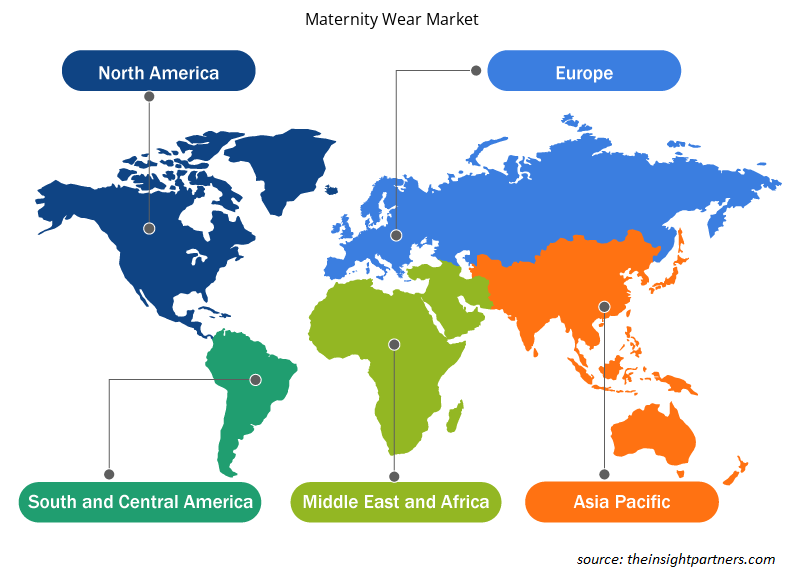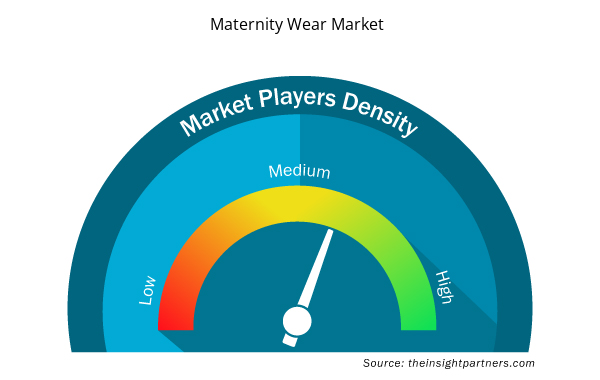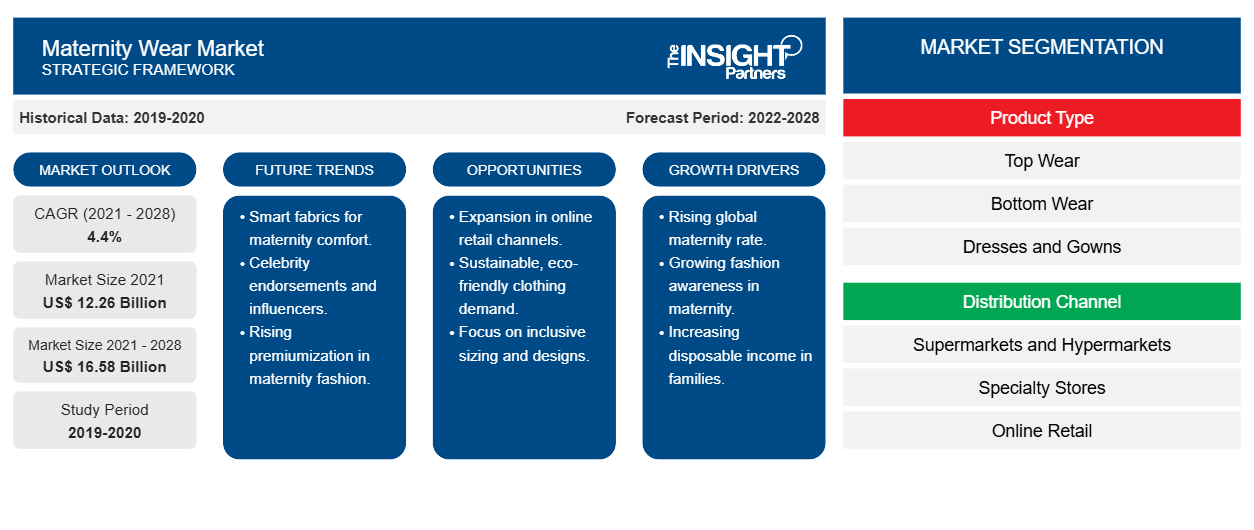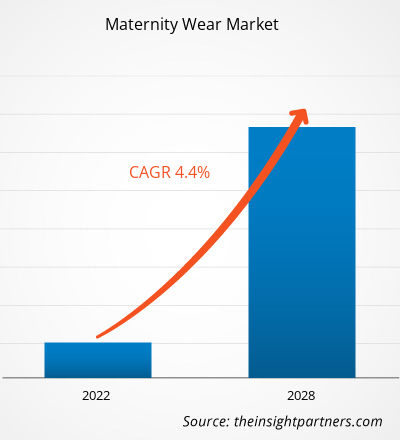2021 年孕妇装市场价值为 122.5741 亿美元,预计到 2028 年将达到 165.7864 亿美元;预计 2021 年至 2028 年的复合年增长率为 4.4%。
孕妇装通常采用宽松、合身的款式,包含松紧带、标签和可拉伸面料,例如氨纶和斯潘德克斯,为消费者在怀孕期间提供额外的舒适感。
2020 年,亚太地区占据了全球孕妇装市场的最大份额,而北美预计在预测期内的复合年增长率最高。根据世界银行的报告,美国平均有 85% 的职业女性怀孕。因此,礼服和长袍类别中孕妇装和大码正装的需求正在增加。这是推动北美孕妇装市场增长的主要因素。
COVID-19 疫情对孕妇装市场的影响
COVID-19 疫情对包括消费品行业在内的许多行业产生了不利影响。疫情导致封锁、企业停工和供应链中断,给企业运营造成了困难。服装和服饰零售店的销售额出现大幅下降。西班牙 Inditex 集团和瑞典 H&M 等时尚品牌发布的财务业绩揭示了疫情的巨大影响。此外,电子商务从疫情中获得了长期利益,因为大多数在线购物者将电子零售视为疫情后的选择。此外,预计在预测期内,疫苗接种率上升、制造业活动复苏和政府监管放宽将对全球孕妇装市场产生积极影响。
定制此报告以满足您的需求
您可以免费定制任何报告,包括本报告的部分内容、国家级分析、Excel 数据包,以及为初创企业和大学提供优惠和折扣
- 获取此报告的关键市场趋势。这个免费样品将包括数据分析,从市场趋势到估计和预测。
市场洞察
采用业务增长战略推动市场增长
市场上的知名企业采用各种策略来克服公司扩张的当前和未来挑战。例如,Isabella Oliver 采取市场渗透策略,推出孕妇装租赁计划来扩大其覆盖范围。2020 年 1 月 20 日,该品牌再次推出一项新的租赁计划,以实现循环利用并延长孕妇装的使用寿命。Isabella Oliver 为客户提供了一系列新的选择,可以租用连衣裙,包括派对服装和基本怀孕必需品,租期为两周,然后免费归还。该品牌甚至负责干洗。顾客也可以购买产品。租赁孕妇装的理念是鼓励顾客更加环保,消除快时尚的影响。因此,产品创新和渗透导致对孕妇装的需求增加。这些因素正在推动孕妇装市场的增长。
分销渠道洞察
根据分销渠道,孕妇装市场分为超市和大卖场、专卖店、在线零售和其他。预计在线零售部门在预测期内的复合年增长率最高。由于实体零售店不被允许营业,电子商务在 COVID-19 大流行的最初几个月发挥了至关重要的作用。在封锁期间,人们越来越多地使用电子商务平台购买必需品和非必需品。由于 COVID-19 疫情爆发而导致的经济危机导致女性可支配收入减少。然而,对孕妇装的需求并未受到影响。因此,有竞争力的定价很可能成为未来整个格局的一个关键特征。预计这一因素将在预测期内潜在地促进在线零售部门的市场增长。
产品类型洞察
根据产品类型,孕妇装市场细分为上衣、下装、连衣裙和长袍以及内衣。上衣部分在 2020 年占据了更大的市场份额,预计连衣裙和长袍部分在预测期内的复合年增长率将更高。孕妇上衣布料包括正装和休闲装。此外,由于职业女性的数量不断增加,对正式孕妇装的需求也在上升。正式孕妇上衣包括 kurtis、衬衫、柔软材质的背心裙、西装外套和双层风衣。休闲装包括束腰外衣、长裙和大码运动衫和 T 恤。孕妇装采用最优质的面料和天然舒适的材料制成,例如棉、莫代尔和竹纤维,因为它们柔软且透气。孕妇倾向于根据季节变化来选择材料。夏天喜欢穿保暖的亚麻衣服,方便透气;冬天则喜欢穿温暖的羊毛大衣,防止着凉。
孕妇装市场的一些参与者包括 Gap Inc、Seraphine、Isabella Oliver、H and M Hennes and Mauritz AB、Brunelli and Co SRL、Mothercare、Boob Design、SHAICO Fashion Pvt. Ltd、Pink Blush Maternity 和 Organic & More。
孕妇装市场区域洞察
Insight Partners 的分析师已详尽解释了预测期内影响孕妇装市场的区域趋势和因素。本节还讨论了北美、欧洲、亚太地区、中东和非洲以及南美和中美洲的孕妇装市场细分和地理位置。

- 获取孕妇装市场的区域特定数据
孕妇装市场报告范围
| 报告属性 | 细节 |
|---|---|
| 2021 年市场规模 | 122.6亿美元 |
| 2028 年市场规模 | 165.8亿美元 |
| 全球复合年增长率(2021 - 2028) | 4.4% |
| 史料 | 2019-2020 |
| 预测期 | 2022-2028 |
| 涵盖的领域 | 按产品类型
|
| 覆盖地区和国家 | 北美
|
| 市场领导者和主要公司简介 |
|
市场参与者密度:了解其对商业动态的影响
孕妇装市场正在快速增长,这得益于消费者偏好的不断变化、技术进步以及对产品优势的认识不断提高等因素导致的终端用户需求不断增加。随着需求的增加,企业正在扩大其产品范围,进行创新以满足消费者的需求,并利用新兴趋势,从而进一步推动市场增长。
市场参与者密度是指在特定市场或行业内运营的企业或公司的分布情况。它表明在给定市场空间中,相对于其规模或总市场价值,有多少竞争对手(市场参与者)存在。
在孕妇装市场运营的主要公司有:
- 盖璞集团
- 塞拉芬娜
- 伊莎贝拉·奥利弗
- H&M 亨尼斯和莫里斯
- 布鲁内利公司
免责声明:上面列出的公司没有按照任何特定顺序排列。

- 了解孕妇装市场主要参与者概况
报告亮点
- 孕妇装市场的渐进式行业趋势可帮助参与者制定有效的长期战略
- 发达市场和发展中市场采用的业务增长战略
- 2019年至2028年孕妇装市场定量分析
- 全球乳制品原料需求量估计
- 波特的五力分析说明了行业中买家和供应商的效力
- 了解竞争市场状况的最新发展
- 市场趋势和前景以及推动和制约孕妇装市场增长的因素
- 通过强调支撑商业利益的市场策略来协助决策过程,从而促进市场增长
- 各节点孕妇装市场规模
- 详细概述和细分市场,以及孕妇装行业动态
- 各地区孕妇装市场规模及增长潜力
- 历史分析(2 年)、基准年、预测(7 年)及复合年增长率
- PEST 和 SWOT 分析
- 市场规模价值/数量 - 全球、区域、国家
- 行业和竞争格局
- Excel 数据集


- Diaper Packaging Machine Market
- Machine Condition Monitoring Market
- Educational Furniture Market
- Microcatheters Market
- Semiconductor Metrology and Inspection Market
- Cut Flowers Market
- Bioremediation Technology and Services Market
- Constipation Treatment Market
- Ceiling Fans Market
- Nuclear Decommissioning Services Market

Report Coverage
Revenue forecast, Company Analysis, Industry landscape, Growth factors, and Trends

Segment Covered
This text is related
to segments covered.

Regional Scope
North America, Europe, Asia Pacific, Middle East & Africa, South & Central America

Country Scope
This text is related
to country scope.
常见问题
The global maternity wear market is driven by the rising number of pregnant working women coupled with the adoption of business growth strategies by the market players.
Based on distribution channel, the supermarkets and hypermarkets segment held the largest market share in 2020. Supermarkets and hypermarkets, considered as an effective distribution channel, are large retail stores that offer a wide range of maternity clothes. Many leading manufacturers of maternity clothes target selling their products through prominent supermarkets and hypermarkets chains, such as Mom & Baby, Mother Care, and FirstCry, as there is high customer traffic in these stores. This factor is also driving the popularity of supermarkets and hypermarkets for purchasing maternity clothes.
Top wear accounted for a major share in 2020. Maternity top-wear cloth consists of formal wear and casual wear. The demand for formal maternity top wear is rising due to the increasing number of working females. Formal maternity top-wear consists of kurtis, blouses, soft material tank dresses, blazers, and trench coats with double layers, and casual wear comprises tunics, maxi dresses, and oversize sweatshirts and t-shirts.
The major players operating in the global maternity wear market are Gap Inc, Seraphine, Isabella Oliver, H & M Hennes and Maurits, Brunelli & Co. S.R.L., Mothercare, Boob Design, Pinkblush Maternity, Adidas America Inc., and Organic and More among others.
In 2020, Asia Pacific held the largest share in the global maternity wear market. Asia-Pacific continent comprises several developing and developed economies such as India, China, Japan, South Korea, and Australia. These emerging countries are witnessing an increase in spending by new mothers to be over their first pregnancy photo-shoots, accompanied by growing purchasing capacity of women in this region.
Trends and growth analysis reports related to Consumer Goods : READ MORE..
The List of Companies - Maternity Wear Market
- Gap Inc
- Seraphine
- Isabella Oliver
- H & M Hennes and Maurits
- Brunelli & Co. S.R.L
- Mothercare
- Boob Design
- Shaico Design Pvt. Ltd.
- Pinkblush Maternity
- Organic & More
The Insight Partners performs research in 4 major stages: Data Collection & Secondary Research, Primary Research, Data Analysis and Data Triangulation & Final Review.
- Data Collection and Secondary Research:
As a market research and consulting firm operating from a decade, we have published and advised several client across the globe. First step for any study will start with an assessment of currently available data and insights from existing reports. Further, historical and current market information is collected from Investor Presentations, Annual Reports, SEC Filings, etc., and other information related to company’s performance and market positioning are gathered from Paid Databases (Factiva, Hoovers, and Reuters) and various other publications available in public domain.
Several associations trade associates, technical forums, institutes, societies and organization are accessed to gain technical as well as market related insights through their publications such as research papers, blogs and press releases related to the studies are referred to get cues about the market. Further, white papers, journals, magazines, and other news articles published in last 3 years are scrutinized and analyzed to understand the current market trends.
- Primary Research:
The primarily interview analysis comprise of data obtained from industry participants interview and answers to survey questions gathered by in-house primary team.
For primary research, interviews are conducted with industry experts/CEOs/Marketing Managers/VPs/Subject Matter Experts from both demand and supply side to get a 360-degree view of the market. The primary team conducts several interviews based on the complexity of the markets to understand the various market trends and dynamics which makes research more credible and precise.
A typical research interview fulfils the following functions:
- Provides first-hand information on the market size, market trends, growth trends, competitive landscape, and outlook
- Validates and strengthens in-house secondary research findings
- Develops the analysis team’s expertise and market understanding
Primary research involves email interactions and telephone interviews for each market, category, segment, and sub-segment across geographies. The participants who typically take part in such a process include, but are not limited to:
- Industry participants: VPs, business development managers, market intelligence managers and national sales managers
- Outside experts: Valuation experts, research analysts and key opinion leaders specializing in the electronics and semiconductor industry.
Below is the breakup of our primary respondents by company, designation, and region:

Once we receive the confirmation from primary research sources or primary respondents, we finalize the base year market estimation and forecast the data as per the macroeconomic and microeconomic factors assessed during data collection.
- Data Analysis:
Once data is validated through both secondary as well as primary respondents, we finalize the market estimations by hypothesis formulation and factor analysis at regional and country level.
- Macro-Economic Factor Analysis:
We analyse macroeconomic indicators such the gross domestic product (GDP), increase in the demand for goods and services across industries, technological advancement, regional economic growth, governmental policies, the influence of COVID-19, PEST analysis, and other aspects. This analysis aids in setting benchmarks for various nations/regions and approximating market splits. Additionally, the general trend of the aforementioned components aid in determining the market's development possibilities.
- Country Level Data:
Various factors that are especially aligned to the country are taken into account to determine the market size for a certain area and country, including the presence of vendors, such as headquarters and offices, the country's GDP, demand patterns, and industry growth. To comprehend the market dynamics for the nation, a number of growth variables, inhibitors, application areas, and current market trends are researched. The aforementioned elements aid in determining the country's overall market's growth potential.
- Company Profile:
The “Table of Contents” is formulated by listing and analyzing more than 25 - 30 companies operating in the market ecosystem across geographies. However, we profile only 10 companies as a standard practice in our syndicate reports. These 10 companies comprise leading, emerging, and regional players. Nonetheless, our analysis is not restricted to the 10 listed companies, we also analyze other companies present in the market to develop a holistic view and understand the prevailing trends. The “Company Profiles” section in the report covers key facts, business description, products & services, financial information, SWOT analysis, and key developments. The financial information presented is extracted from the annual reports and official documents of the publicly listed companies. Upon collecting the information for the sections of respective companies, we verify them via various primary sources and then compile the data in respective company profiles. The company level information helps us in deriving the base number as well as in forecasting the market size.
- Developing Base Number:
Aggregation of sales statistics (2020-2022) and macro-economic factor, and other secondary and primary research insights are utilized to arrive at base number and related market shares for 2022. The data gaps are identified in this step and relevant market data is analyzed, collected from paid primary interviews or databases. On finalizing the base year market size, forecasts are developed on the basis of macro-economic, industry and market growth factors and company level analysis.
- Data Triangulation and Final Review:
The market findings and base year market size calculations are validated from supply as well as demand side. Demand side validations are based on macro-economic factor analysis and benchmarks for respective regions and countries. In case of supply side validations, revenues of major companies are estimated (in case not available) based on industry benchmark, approximate number of employees, product portfolio, and primary interviews revenues are gathered. Further revenue from target product/service segment is assessed to avoid overshooting of market statistics. In case of heavy deviations between supply and demand side values, all thes steps are repeated to achieve synchronization.
We follow an iterative model, wherein we share our research findings with Subject Matter Experts (SME’s) and Key Opinion Leaders (KOLs) until consensus view of the market is not formulated – this model negates any drastic deviation in the opinions of experts. Only validated and universally acceptable research findings are quoted in our reports.
We have important check points that we use to validate our research findings – which we call – data triangulation, where we validate the information, we generate from secondary sources with primary interviews and then we re-validate with our internal data bases and Subject matter experts. This comprehensive model enables us to deliver high quality, reliable data in shortest possible time.


 获取此报告的免费样本
获取此报告的免费样本